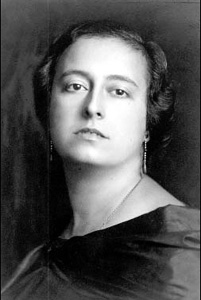Conchita Badía facts for kids
Concepció Badia Millàs (born November 14, 1897 – died May 2, 1975), known as Conxita Badia, was a talented Spanish singer (soprano) and pianist. People admired her for her natural singing, how much feeling she put into her music, and her clear voice. She was seen as one of the best singers of "art songs" from Spain, Catalonia, and Latin America in the 20th century.
Conxita Badia was the first to perform many new songs. These included works by famous composers like Enrique Granados, Manuel de Falla, Frederic Mompou, Alberto Ginastera, and Enric Morera. Many of these songs were written especially for her voice! A famous musician, Pablo Casals, once wrote to her: "Everything I've written for a soprano voice has been thinking about you. Therefore, every one is yours." Most of her recordings, music, letters, and photos are kept safe at the Biblioteca de Catalunya (Library of Catalonia).
Contents
Life and Music Journey
Conxita Badia was born in Barcelona, Spain, on November 14, 1897. She studied music with important teachers like Enrique Granados, Manuel de Falla, and Pablo Casals. She first joined the Granados Academy to learn piano. But her teacher, Granados, discovered her amazing singing voice during a music test!
Early Performances
Conxita first appeared on stage in 1913 when she was only 16 years old. She was one of six "flower maidens" in a performance of Wagner's opera Parsifal at the Palau de la Música Catalana. Her first solo concert was on April 5, 1915. She sang songs from Granados's Canciones Amatorias, with the composer himself playing the piano. Two of these songs were even dedicated to her!
Sadly, Granados and his wife died in 1916 when their ship sank. Conxita performed in many concerts across Spain and Europe to honor his memory. In 1935, she sang the main role in the opera María del Carmen. This was the first time this opera had been performed again since it first came out many years before.
Singing Across Europe
During the 1930s, Conxita gave many concerts in Spain and other parts of Europe. From 1936 to 1938, because of the Spanish Civil War, she performed even more often in cities like London, Brussels, Geneva, Paris, Vienna, and Salzburg. In Vienna, she sang Roberto Gerhard's Sis cançons populars catalanes in 1932. Gerhard, another composer, had also dedicated some of his early songs to her. He said about her: "She feels such an intense joy when she sings – joy in the music, joy in her own voice – that it is impossible not to share it when you listen to her."
Life in South America
Conxita married Ricard Agustí Montsech in 1919, and they had three daughters. In 1936, Conxita and her daughters left Spain to escape the Spanish Civil War. Her husband was working in South America at the time. They first lived in Paris, then in Rio de Janeiro, before moving to Argentina. Her husband joined them there in 1938.
In Argentina, she continued to work closely with her friend, composer Manuel de Falla, who was also living there. She also worked with many other artists, including Argentine composers Juan Jose Castro, Carlos Guastavino, and Alberto Ginastera, and Brazilian composer Heitor Villa-Lobos.
Return to Catalonia and Teaching
In 1946, Conxita and her family returned to Catalonia. She then introduced many of the songs she had learned in South America to audiences in Spain and Europe. She often performed with her close friend, the pianist Alicia de Larrocha.
After returning home, Conxita also taught singing and piano. She taught privately and later became a professor at Barcelona's Municipal Conservatory of Barcelona. Some of her students became famous, like the pianist Joaquín Nin-Culmell and the soprano Montserrat Caballé. She also helped judge international singing competitions in South America and Europe.
Conxita Badia passed away in Barcelona on May 2, 1975. In 1997, special concerts and an exhibition were held to celebrate 100 years since her birth. A documentary film called Conxita Badia no existeix was made in 2012 by her great-granddaughter, Eulàlia Domènech. It tells the story of her life and work. Most of her recordings, music, letters, and photos were given by her daughters to the Biblioteca de Catalunya, where they are kept for everyone to learn from.
Recordings
Conxita Badia made many recordings throughout her life. These recordings let us still hear her beautiful voice today. Here are some examples of her recorded music:
- Conchita Badía: Homenaje – This album features songs by Manuel de Falla, Juan José Castro, Alberto Ginastera, and others. It includes recordings from 1942 concerts where de Falla himself conducted his music, sung by Badía. It also has recordings from her 1964 concert in Madrid, which featured songs by Argentinian composers written just for her.
- The Catalan Piano Tradition – On this album, you can hear Conxita Badía singing three songs by Enrique Granados. She is joined by Alicia de Larrocha on the piano. These were recorded around 1960.
- The Record of Singing: Vol. 3 - 1926-1939 – This collection includes Conxita Badía singing two more songs by Enrique Granados. These were recorded in Argentina in 1940.
- Homage to Granados – This album is a tribute to Enrique Granados. Conxita Badía sings many of his songs, with Alicia de Larrocha playing the piano.
- La Renaixenca – Here, Conxita Badía sings songs by Francesc Alio and Enric Morera, with Pere Vallribera on piano.
Images for kids
See also
 In Spanish: Conchita Badía para niños
In Spanish: Conchita Badía para niños



